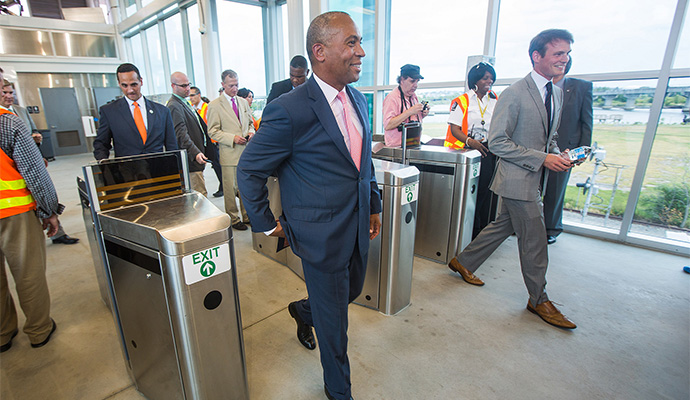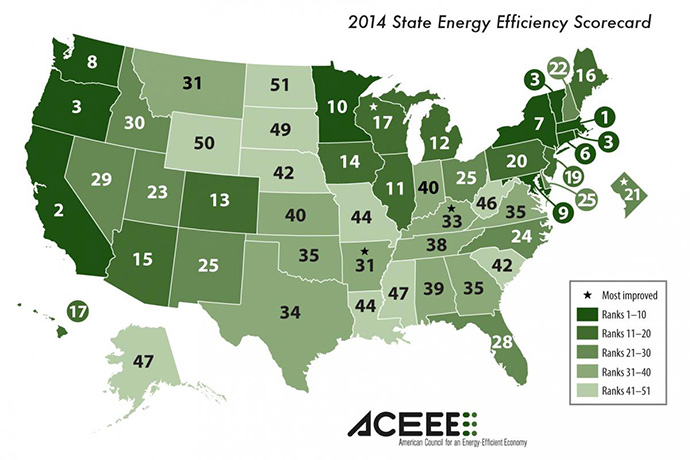The 8th edition of the
State Energy Efficiency Scorecard, released Oct. 21 by the American Council for an Energy-Efficient Economy (ACEEE), reported that Massachusetts continues to edge out California as the most energy-efficient state in the nation for the fourth year in a row. Following these states in the top 10 are: Rhode Island (marking the state’s first time in top five), Oregon, and Vermont (all tied for third); Connecticut (No. 6); New York (No. 7); Washington (No. 8); Maryland (No. 9); and Minnesota (No. 10).
“We have treated efficiency as our first fuel,” said outgoing Massachusetts Gov. Deval Patrick, “because saving energy, managing costs and reducing environmental impacts while building a stronger cleantech economy helps fulfill our responsibility to future generations to leave a stronger Commonwealth than we found.”
The Commonwealth’s energy efficiency and clean energy goals were outlined when Gov. Patrick signed the Green Communities Act, the Green Jobs Act and the Global Warming Solutions Act in 2008. ACEEE continues to highlight the Green Communities Act as a central component to Massachusetts’ achievements as it requires the state’s investor-owned electric and natural gas utilities to prepare energy efficiency plans and pursue “all cost effective energy efficiency.”
Massachusetts earned a perfect score in the Utility & Public Benefits Programs and Policies category of the Scorecard, which accounts for 20 of the Scorecard’s 50 points. (The leading states in utility-sector energy efficiency programs and policies were Rhode Island, Massachusetts, and Vermont.) The governor’s office said the state’s successful programs are the result of collaboration between the Department of Energy Resources (DOER), the Energy Efficiency Advisory Council, energy efficiency Program Administrators and sponsors of Mass Save®.
Among the other tools in Massachusetts’ arsenal:
- The Transit-Oriented Development (TOD) Bond Program is intended to increase compact, mixed-use, walkable development close to transit stations.
- A welter of green building and energy management requirements for state buildings, including an Accelerated Energy Program announced in January 2013 that calls for a 25-percent reduction in energy, greenhouse gas emissions and energy costs at 58 million sq. ft. of state buildings.
- The Center for Energy Efficiency and Renewable Energy (CEERE) at the University of Massachusetts at Amherst provides technological and economic solutions to environmental problems resulting from energy production, industrial, manufacturing, and commercial activities, and land use practices. The university-based research program is built upon four subgroups of Renewable Energy Resources, Building Energy Efficiency, Industrial Energy Efficiency, and Environmental Technologies with unique abilities to service energy and environmental problems. The Center has 43 faculty and staff and is funded in part through U.S. DOE grants.
- Massachusetts is also leveraging $4.5 million in grants to pilot programs to demonstrate energy-efficient technologies in the building sector.
“Energy efficiency’s benefits go beyond greenhouse gas reductions and lower energy costs – it has become a true economic driver in the Commonwealth,” said Alicia Barton, CEO of the Massachusetts Clean Energy Center. “Because of the investments Massachusetts has made, there are more than 4,000 companies with over 65,000 workers inventing, delivering, and exporting energy efficiency technologies to national and global markets.”
The 2013-2015 Statewide Three-Year Energy Efficiency Plans, credited in the report, are expected to deliver energy benefits of nearly $9 billion to residents, businesses, and state and local governments based on an investment of $2.8 billion.
Meanwhile, renewables are doing their part. In 2007, Massachusetts had just over three megawatts each of solar and wind capacity installed. “Today there are more than 650 megawatts of solar installed,” said the state, “with a goal of 1,600 megawatts by 2020. The Commonwealth has installed 106 megawatts of land-based wind and [is] poised to be home to the nation’s first offshore wind farm.”
In September 2014, Gov. Patrick — whose office now will coordinate a transition to just-elected incoming Republican Gov. Charlie Baker after a narrow victory Nov. 4 — announced the 2014 Massachusetts Clean Energy Industry Report, showing that the clean energy sector now includes more than 88,000 employees and nearly 6,000 businesses. The clean energy sector in Massachusetts grew by 10.5 percent, the fourth year of double-digit growth, said the state.

After the opening ceremony of the new Assembly Orange Line MBTA station in Boston Sept. 2, Massachusetts Gov. Deval Patrick rides the T back to the State House. Transit investment and transit-oriented development have been strong focal points for the Patrick administration.
Photo by Eric Haynes courtesy of the Governor’s Office
Doing Something
ACEEE’s state scores are calculated based on 31 metrics covering utility efficiency programs and policy, transportation, building energy codes, combined heat and power projects, state government initiatives and appliance efficiency standards.
But the ACEEE scores well for efficiency itself too: It sent a total of 108 requests to state energy offices and public utility commissions for the scorecard, and experienced a 92-percent response rate.
Arkansas, the District of Columbia, Kentucky, and Wisconsin are the four most improved energy-efficiency states for 2014.
“Arkansas pushed forward with strong utility programs,” said the scorecard. “The state’s budgets for electric efficiency programs increased 30 percent between 2012 and 2013, while electricity savings more than tripled. The District of Columbia and Wisconsin also saw upticks in energy savings. Kentucky took notable steps to adopt a more efficient commercial building energy code.”
Other states making progress included Nevada, which scored additional points for its building codes and compliance measures, and Delaware, where legislators passed a significant energy efficiency bill in early July, laying the groundwork for customer-funded energy efficiency programs.
Wisconsin rose six places to 17th in the rankings. “Focus on Energy’s program efforts are back on track after a shift in program administrators,” said the report, “and the state is seeing energy savings rise even as budgets remain consistent. The state is also effectively encouraging the development of combined heat and power.” The state scored 2.5 out of five points for its combined heat and power policies. The state has an interconnection standard, and includes CHP as an eligible resource in its renewable portfolio standard. Wisconsin also offers incentives for CHP projects. Nine new CHP installations were completed in 2013.
Other key findings in the Scorecard include:
- The leading state in building energy codes and compliance was
California. Eleven states and the District of Columbia have officially adopted the latest standards for both residential and commercial buildings. - California and New York led the way in
energy-efficient transportation policies. “California’s requirements for reductions in greenhouse gas (GHG) emissions have led it to identify several strategies for smart growth,” said the report, “while New York is one of the few states in the nation to have a concrete vehicle-miles-traveled reduction target.” - “From dead last and up, the five states most in need of improvement on energy efficiency in 2014 are
North Dakota, Wyoming, South Dakota, Mississippi, and Alaska.” - Savings from electricity efficiency programs in 2013 totaled approximately 24.4 million megawatt-hours (MWh), a
7-percent increase over 2011 savings reported last year by ACEEE. Gas savings for 2013 were reported at 276 million therms (MMTherms), a
19-percent increase over the 2011 savings. - A total of
23 states fell in the energy efficiency rankings in 2014. “Indiana dropped the furthest, by 13 spots, due in part to state legislators’ decision to eliminate the state’s long-term energy savings goals,” said the report. “Legislators in Ohio made a similar decision to freeze and substantially weaken the state’s energy efficiency resource standard (EERS), contributing to the state’s fall of seven spots down the rankings.”
The states with the most aggressive savings targets include Arizona, Massachusetts, and Rhode Island.
“More and more governors and state lawmakers understand that they have a choice – do nothing as costly energy is wasted, or take action by creating incentives to waste less energy,” said Maggie Molina, director of ACEEE’s Utilities, State, and Local Policy program. “Smart energy efficiency choices maintain the same comfort, convenience, and quality of life that consumers want and expect. Energy efficiency is also good for business. State action on energy efficiency improves bottom lines, drives investment across all sectors of the economy, creates jobs, and offsets the environmental harms created by the energy production system.”
